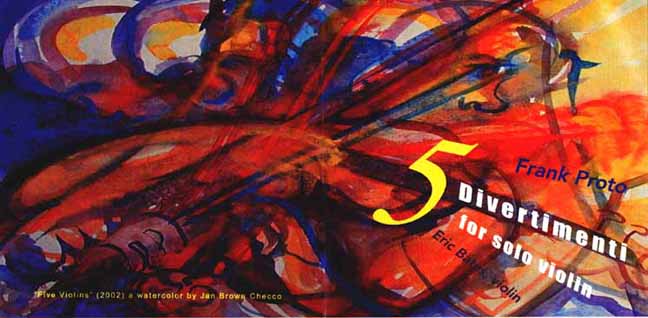
|

|

"Frank Proto's Five Divertimenti for Solo Violin are highly imaginative, improvisatory and challenging works that are a welcome addition to the violin repertoire"
Ruggiero RicciFive Divertimenti for Solo Violin Eric Bates performs the world premiere recording Frank Proto's new set of virtuoso pieces for the Violin
Go to Playview Feature
Hear Audio Excerpts of the music
Red Mark CD 9221
See reviews
Notes by Jonathan Kramer (excerpts)
In some ways, Proto's works for solo violin contradict the divertimento tradition. His is not background music. This is music that commands our attention, that draws us into its special world. This is concert music, not background music. And this music was not commissioned by a moneyed third party: Proto and Eric Bates are proud of the fact that they did everything themselves, without financial support or artistic influence from commissioning parties, recording engineers, or CD producers.
In other ways, however, Proto's divertimenti do carry on in the tradition of their eighteenth-century forebears. Like the divertimenti of Mozart, they do not respect or even recognize a rigid distinction between art and vernacular music. Proto's divertimenti belong equally to the traditions of classical music and jazz. His roots lie in jazz, and it is essentially impossible for him to write any music that is not infused with the spirit of this quintessentially American art form. Yet he is also a thoroughly schooled classical performer, who can hardly set aside his training. The divertimenti are less overtly jazz like than some of his earlier "crossover" pieces, however, and therein lies their unique artistry. Despite being composed for one of classical music's archetypal instruments, these are not classical sonatas containing references to jazz. In much recent classical music that utilizes jazz or other vernacular styles, the popular is often treated like the exotic "other"--like a foreign guest at a party, someone who is valued precisely for his or her difference. In these divertimenti more than in his earlier pieces, jazz and classical come together seamlessly to produce an idiom--Proto's own personal idiom--equally indebted to both traditions but completely at home in neither.
Talking about the jazz flavor of the violin Divertimenti, Proto cites "the rhythmic vitality, use (or non-use) of vibrato, note attacks, etc., which are most (but not all) of the time rooted in these pieces. A perfect example is in the last movement of divertimento No. 1."
Music like this, which belongs equally to two traditions, requires a special kind of performer. Eric Bates typifies a new breed of virtuoso, who deeply understands both kinds of music. He is more than a crossover artist sampling jazz licks, feeling how to swing, exploring how different an interpretation can be from one performance to the next. Like several other young musicians, but like notably few from older generations, he is playing for classical audiences and for jazz audiences alike. Neither group is going to hear him as an interloper, as someone from another world paying a brief visit on foreign turf. He knows how to communicate to listeners experienced in both traditions. He plays Proto's virtuosic figures and soulful melodies in ways that are at once faithful to the composer's conception and yet go beyond what is in the written score. Proto has thus entrusted Bates with those magical "things that we can't write into the music. And if we try, it never seems to work. These pieces need a player with blazing technique and the musical wherewithal" to enter into the extraordinarily varied panoply of musics that inhabit these divertimenti.
See Printed Edition
Click to view or download a PDF sample of the Music

